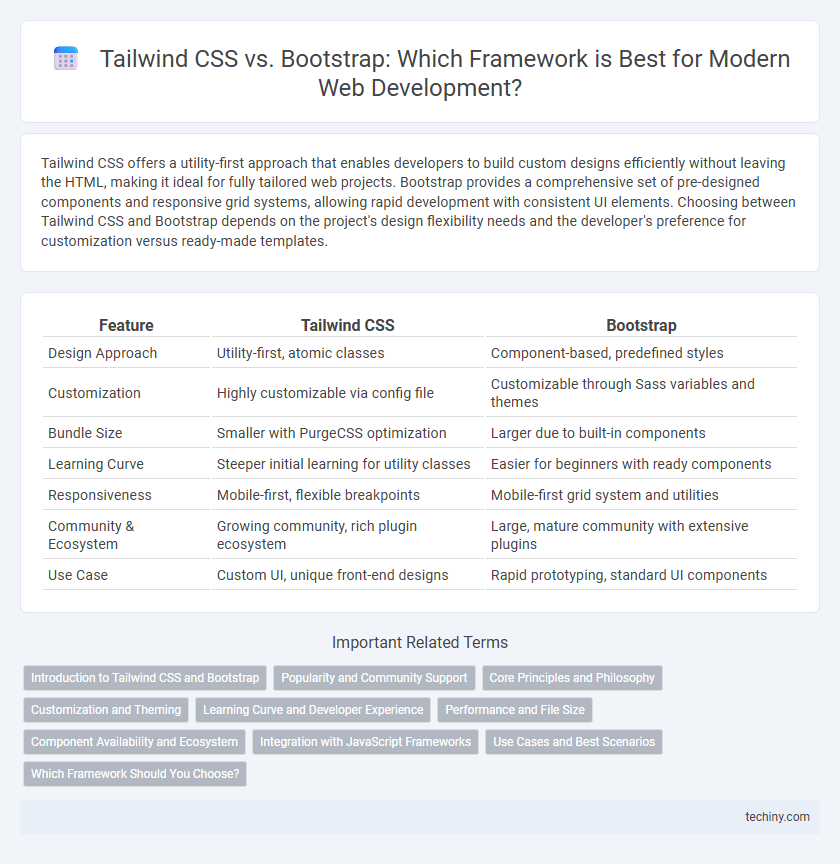Tailwind CSS offers a utility-first approach that enables developers to build custom designs efficiently without leaving the HTML, making it ideal for fully tailored web projects. Bootstrap provides a comprehensive set of pre-designed components and responsive grid systems, allowing rapid development with consistent UI elements. Choosing between Tailwind CSS and Bootstrap depends on the project's design flexibility needs and the developer's preference for customization versus ready-made templates.
Table of Comparison
| Feature | Tailwind CSS | Bootstrap |
|---|---|---|
| Design Approach | Utility-first, atomic classes | Component-based, predefined styles |
| Customization | Highly customizable via config file | Customizable through Sass variables and themes |
| Bundle Size | Smaller with PurgeCSS optimization | Larger due to built-in components |
| Learning Curve | Steeper initial learning for utility classes | Easier for beginners with ready components |
| Responsiveness | Mobile-first, flexible breakpoints | Mobile-first grid system and utilities |
| Community & Ecosystem | Growing community, rich plugin ecosystem | Large, mature community with extensive plugins |
| Use Case | Custom UI, unique front-end designs | Rapid prototyping, standard UI components |
Introduction to Tailwind CSS and Bootstrap
Tailwind CSS is a utility-first CSS framework offering low-level, atomic classes that enable developers to build custom designs directly in HTML, promoting rapid and flexible UI development. Bootstrap, a widely-used front-end framework, provides pre-designed components and a grid system that accelerates responsive web design with consistent styling patterns. Both frameworks streamline styling processes but differ in approach: Tailwind emphasizes customization through utility classes, while Bootstrap focuses on predefined components and theming.
Popularity and Community Support
Tailwind CSS has surged in popularity due to its utility-first approach, attracting developers who prefer custom, scalable design without overriding styles, while Bootstrap maintains a strong user base with extensive prebuilt components and decades of usage. The Tailwind community rapidly expands through active GitHub contributions, specialized plugins, and modern frontend integrations, whereas Bootstrap benefits from a mature ecosystem, comprehensive documentation, and widespread adoption in enterprise projects. Both frameworks offer robust community support, but Tailwind's growth reflects a shift toward more flexible, design-oriented tools in contemporary web development.
Core Principles and Philosophy
Tailwind CSS emphasizes utility-first design, providing low-level classes that enable developers to build custom interfaces without overriding predefined styles, fostering rapid and flexible development. Bootstrap focuses on a component-based framework with pre-designed, opinionated styles and JavaScript plugins, offering consistency and ease of use for standardized UI patterns. Tailwind's philosophy prioritizes design freedom and minimal CSS bloat, while Bootstrap centers on comprehensive, ready-made components and responsive grid systems.
Customization and Theming
Tailwind CSS offers unparalleled customization through its utility-first approach, enabling developers to create unique designs by directly applying CSS classes without overriding predefined styles. Bootstrap provides a robust theming system with pre-built components and Sass variables, allowing for easier but more constrained customization compared to Tailwind's granular control. Tailwind's flexibility supports intricate theming and design systems, while Bootstrap excels in rapid prototyping with consistent, predefined styles.
Learning Curve and Developer Experience
Tailwind CSS offers a steeper learning curve initially due to its utility-first approach, requiring developers to compose styles directly in HTML, which can be unfamiliar but allows for greater customization and faster prototyping. Bootstrap provides a more straightforward learning experience with predefined components and a consistent grid system, making it ideal for beginners seeking quick, standardized layouts. Developer experience with Tailwind often improves over time as familiarity grows, promoting reusable design systems, while Bootstrap's extensive documentation and component library ensure reliable, tried-and-tested UI development.
Performance and File Size
Tailwind CSS offers superior performance and smaller file sizes compared to Bootstrap by generating only the necessary utility classes used in the project, minimizing CSS bloat. Bootstrap's comprehensive component library increases its base file size, leading to heavier initial loads and slower rendering times. Optimizing with Tailwind's tree-shaking capabilities significantly reduces unused CSS, enhancing load speed and overall web application performance.
Component Availability and Ecosystem
Tailwind CSS offers a utility-first approach with a customizable but minimal default component library, encouraging developers to build unique, reusable UI elements from scratch. Bootstrap provides an extensive range of pre-built, responsive components and JavaScript plugins, facilitating rapid development with consistent design patterns. The Bootstrap ecosystem benefits from a vast community and numerous third-party themes, while Tailwind's ecosystem excels in flexibility and integrates smoothly with modern build tools and component frameworks like React and Vue.
Integration with JavaScript Frameworks
Tailwind CSS offers seamless integration with modern JavaScript frameworks like React, Vue, and Angular by providing utility-first classes that enhance component styling flexibility without overriding framework styles. Bootstrap's comprehensive prebuilt components simplify development but may require additional configuration to customize within JavaScript frameworks, potentially causing style conflicts. Developers seeking granular control and responsiveness often prefer Tailwind CSS for its modular approach and compatibility with dynamic UI rendering in JavaScript frameworks.
Use Cases and Best Scenarios
Tailwind CSS excels in projects requiring highly customizable user interfaces with a utility-first approach that minimizes CSS bloat, making it ideal for developers seeking fine-grained control over styling in single-page applications and rapidly evolving designs. Bootstrap is best suited for conventional web development with a need for quick prototyping and responsive, consistent components, particularly in enterprise-level projects or dashboards where predefined UI elements and grid systems simplify development. Both frameworks enhance productivity but choosing Tailwind CSS or Bootstrap depends on whether customization flexibility or ready-to-use components are prioritized in the project.
Which Framework Should You Choose?
Tailwind CSS offers a utility-first approach for highly customizable and scalable designs, enabling developers to build unique interfaces without predefined components. Bootstrap provides a comprehensive set of pre-styled components and responsive grid systems, making it ideal for rapid prototyping and consistent UI across projects. Choosing between Tailwind CSS and Bootstrap depends on whether you prioritize design flexibility and control or speed and simplicity in development workflows.
Tailwind CSS vs Bootstrap Infographic

 techiny.com
techiny.com